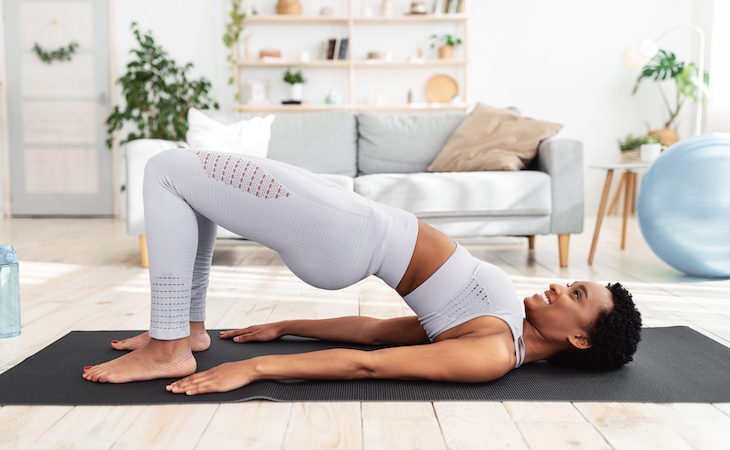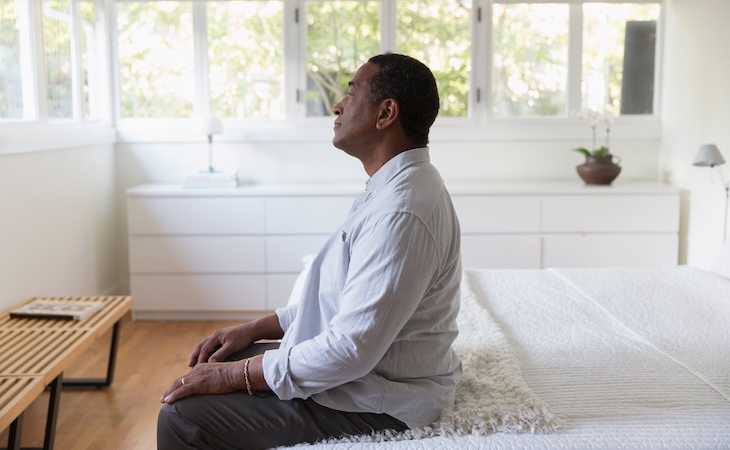It seems fair to say that much of our population is plagued with stress, exhaustion, and fatigue. The Centers for Disease Control and Prevention recommends that adults ages 18-60 receive a minimum of seven hours of sleep—yet 35% of Americans get less than that.
Insufficient sleep can lead to a wide variety of health issues, such as heart disease, high blood pressure, and diabetes (to name a few)—and can make a person feel run-down and oftentimes outright grumpy.
Research shows there are many ways to improve your sleep habits, including maintaining a consistent bedtime, engaging in daily physical activity, spending time outdoors, and eating healthy foods.
Pilates for sleep health
Engaging in Pilates can also greatly enhance your sleep health by directing awareness to the body, enhancing oxygen intake through proper breathing techniques, and promoting improved blood flow and circulation through movement based on proper alignment.
Joseph Pilates wrote in his book, Return to Life Through Contrology: “Breathing is the first act of life, and the last. Our very life depends on it. Since we cannot live without breathing it is tragically deplorable to contemplate the millions and millions of people who have never learned to master the art of correct breathing.”
Learning to breathe properly is the key to effectively oxygenating our body! Bringing vital nutrients to our body through proper breathing practice enables us to boost energy levels when necessary and promote complete relaxation when needed.
In Pilates, individuals are encouraged to utilize ribcage expansion through proper engagement of the diaphragm while breathing, offering our bodies a full supply of oxygen.
By slowing the breath and encouraging full breathing, we can allow the body to switch from a sympathetic nervous system state (associated with the fight-or-flight response) into a parasympathetic state, inducing a state of relaxation. This relaxed state fosters the regular release of serotonin, contributing to improved sleep patterns.
Awareness is another valuable tool incorporated in Pilates that relates to developing positive sleep patterns. Thoughts rule many of our worlds. Have you ever laid in bed at night and watched or listened to thoughts in your head that never stop? It’s a very common experience for many in today’s world.
In fact, the term “monkey mind” has been coined to describe uncontrolled thoughts in the mind. Overthinking can lead to stress, insomnia, and overall fatigue in the body.
Pilates teaches individuals awareness. Learning how to feel exercises; noticing how the body responds; and learning more about your alignment, strengths, and weaknesses through movement are all part of an awareness practice.
In Pilates, each movement is precise and intentional. Joseph Pilates designed a practice that was intended to be executed with mindfulness and attention to detail. If done correctly, some exercises are so challenging that they may only need to be practiced once at a time!
By practicing awareness, you can learn to direct your thoughts, even if only for a moment. The practice of redirecting your thoughts is useful when insomnia sets in.
Pilates might serve as an alternative approach to the traditional counting sheep method! Incorporating just 10 minutes before bedtime could contribute to improved sleep quality.
Movement is extremely important for optimal sleep. Any time we move the body, we’re encouraging blood flow, circulation, and better health. It’s widely acknowledged that physical exercise helps to strengthen the body and heart and reduces stress and tension.
This can, in turn, help alleviate insomnia! One of the most beautiful things about Pilates is that it’s a gentle practice that can be practiced by every “body” with highly positive results. The term “everyBODY” is a very important piece of the previous statement because there are many forms of exercise out there that aren’t safe for all populations.
Pilates might serve as an alternative approach to the traditional counting sheep method! Incorporating just 10 minutes before bedtime could contribute to improved sleep quality.
Maria Pertile, master instructor for Club Pilates
Those with injuries, dysfunctions, and special populations can practice Pilates with confidence, knowing that there are modifications specific to every individual that allow for safe and effective participation.
Pilates is an alignment-based practice that encourages each individual to move their body in their own, unique optimal alignment, which may have been affected physically, emotionally, or spiritually.
When moving optimally, we can find space to let go of stress and allow for a more relaxed state of being, resulting in better sleep overall.
5 Pilates exercises to do before bed
The exercises provided below are based on the theory that moving the spine in all directions encourages blood flow and oxygen throughout the entire body. Additionally, many people suffer from insomnia simply from chronic back issues and these few movements can help to relieve symptoms of back pain.
Breathwork
- Lie on your back on the floor with your knees bent, feet on the floor, upper body relaxed, and hands on the rib cage.
- Breathe in through the nose, filling air into the ribs, and feel the hands move with the ribs as they expand.
- As you exhale, cinch the waist, and feel the support of the spine wrap around the belly.
Repeat three to five reps. This simple breath pattern helps to encourage proper, relaxed breathing and oxygenation of the body.
Shoulder bridge
- Starting position: lying on your back, knees bent, feet on the floor
- Explore the concept of a neutral spine, which means that the lower lumbar has a natural curve of slight space away from the floor.
- Inhale fully, then as you exhale, tilt the pelvis and articulate the spine off the ground one vertebra at a time until only the bottom of your shoulder blade is on the floor.
- Inhale again to feel the strength and support of your glutes and hamstrings with your back off the ground.
- With the exhale, allow the spine to drop to the earth one at a time until the spine is fully back on the ground and supported.
Repeat three to five reps. This gentle articulation of the spine increases blood flow and helps to relieve spinal tension and stiffness.
Note: If spinal injuries, fusions, or osteoporosis exist, omit the articulation and simply hinge the hips up in a neutral spine position and release back down.
Lateral flexion
- Starting position: seated upright, with legs extended and hands behind head
- If the hamstrings are too tight to sit upright, then stand or sit in a chair.
- Inhale as you sit tall. As you release your breath, laterally bend, or flex, the body to one side. Inhale hold for a moment, and as you exhale, return to the starting position and go all the way to the other side.
Repeat three to five reps. Moving the spine laterally helps to increase movement in the intercostals and flexibility of the spine in the frontal plane and encourages blood flow.
Spinal rotation
- From the same seated position open both arms to the side, palms facing down.
- Inhale to sit as tall as possible facing front. As you exhale, rotate as far as possible to one side making sure that neither arm passes the midline of the body. Pulse three times.
Repeat to alternating sides three to five times. Rotation of the spine is an essential movement of the spine to encourage flexibility, blood flow, and oxygenation of the body.
Spinal extension
- From the same seated position (knees bent if needed, or in a chair so that the spine is neutral), reach both arms straight up in the air with palms facing forward.
- Inhale. Bend elbows and draw them down creating a “cactus” or “goal post” shape as you gently extend the thoracic spine looking slightly up.
- Exhale. Reach your arms back up as you return the spine to a tall neutral position with your arms overhead.
Repeat three to five times.
End your practice with knees bent and spine relaxed over thighs in a rested position. Breathe gently in and out feeling how the breath moves through the ribcage relaxing the shoulders and neck.
Does Pilates help sleep? The bottom line
In closing, insomnia is a common problem for many, but there are solutions. Pilates is a beautiful practice centered around breathing techniques, proper body alignment, and mobility. Try these five simple moves to enhance relaxation, increase body awareness, and improve blood circulation, paving the way for a more restful sleep tonight!
Certain exercises can be done without ever leaving your bed. Check out our list of effective exercises that can be done from bed.




